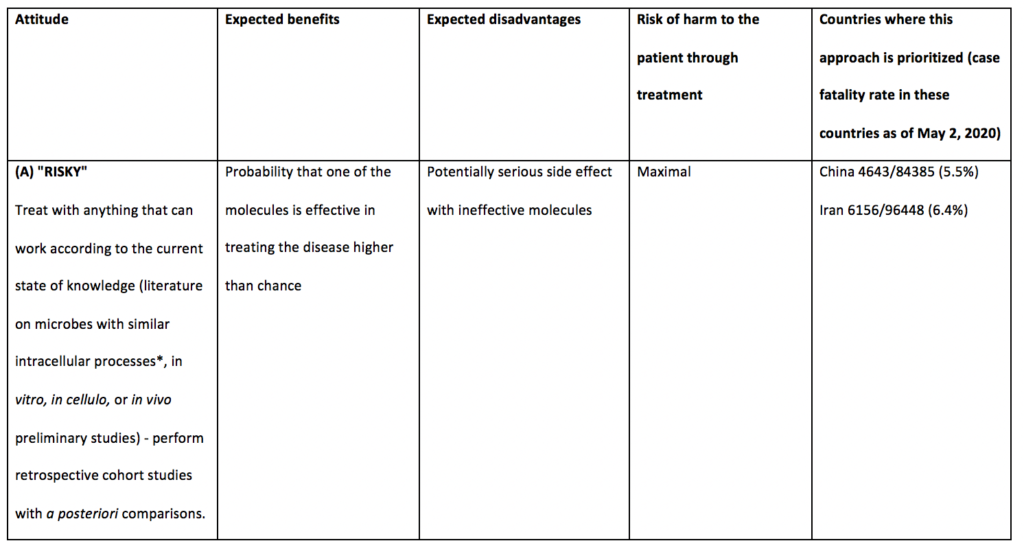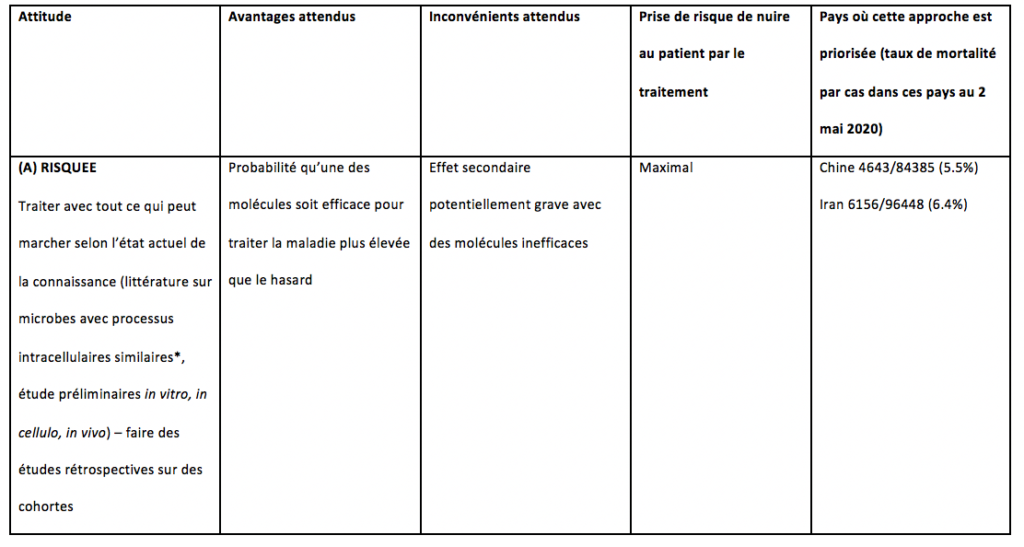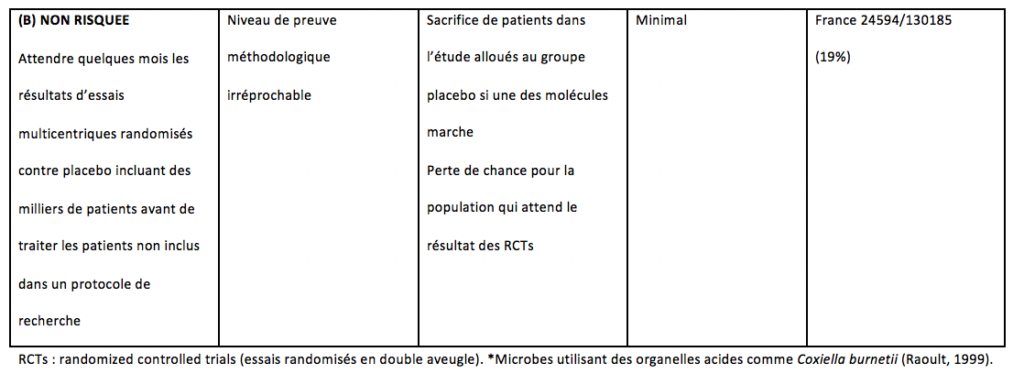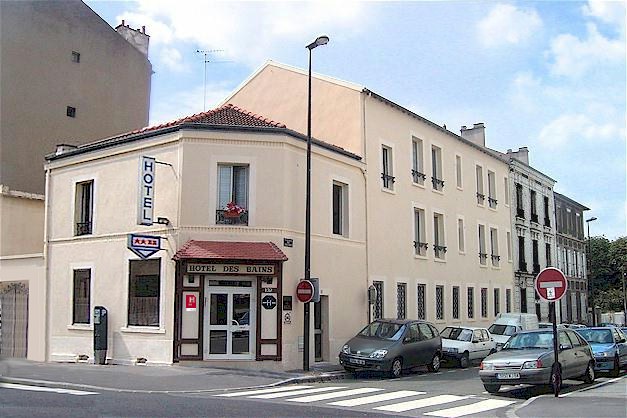(Traduction française ci-après)
Comment on the study by Yu et al. MedRxiv 2020 : Hydroxychloroquine reduces the risk of death by a factor of three in COVID-19 inpatients in intensive care units: Retrospective study of 568 Wuhan patients.
- Matthieu MILLION1,2, Yanis ROUSSEL1,2, Didier RAOULT1,2
- 1IHU-Méditerranée Infection, Marseille, France
- 2Aix Marseille Univ, IRD, AP-HM, MEPHI, Marseille, France
We read with interest the retrospective study by Yu et al. released on www.medrxiv.org on May 1, 2020 (Yu, 2020). This is the first robust study investigating the impact of chloroquine derivatives on mortality. Two previous studies with conflicting results had analysed mortality but critical scientific anomalies were suspected in these studies (Million, 2020a & b – Brouqui, 2020). This is a retrospective study conducted at the epicentre of the pandemic in the city of Wuhan in China. Forty-eight received hydroxychloroquine (HCQ) 200 mg times 2 per day for 7-10 days. 520 did not receive it. The two groups were comparable in age, gender, co-morbidities (hypertension, coronary artery disease, chronic obstructive pulmonary disease, and diabetes), severity (oxygen saturation, oxygen therapy, mechanical ventilation), antiviral treatments (lopinavir/ritonavir, entecavir, ribavirin), intravenous immunoglobulins, and immunomodulators. Patients receiving HCQ had less frequent use of antibiotics and interferon (p < .05). Therefore, it is not possible that the observed benefit was related to antibiotics or interferon.
Like all Chinese and Iranian studies (Million, 2020a), patients could receive multiple antivirals. This therapeutic attitude contrasts with the attitude of some Western countries (Table 1). In the study by Yu et al. the effect of co-morbidities was ruled out by a Cox regression model that controls for confounding factors. Here, a first model was made with medical history (age, sex, hypertension, diabetes, coronary artery disease, chronic obstructive bronchitis) and elements of disease severity (oxygen saturation). A second model was conducted with the treatments used at admission. In both cases, the use of hydroxychloroquine was associated with a risk of death divided by 3 (hazard ratio 0.33, p < .005).
One of the strengths of this study is to identify a possible pathophysiological mechanism. Indeed, the results of the study show a very significant decrease (concentration divided by 4) of interleukin-6 (IL-6) in patients treated with HCQ while there was an increase in untreated patients. It has previously been shown that IL-6 at admission is predictive of progression to respiratory distress (Herold, 2020). According to the study by Herold et al., IL-6 is an almost perfect predictor (ROC analysis, area under the curve 0.98 – p = 1.7 x 10-8). Above 80 pg/mL the predictive value for intubation was 92% with an intubation time of 1.5 days (range 0-4 days). These results suggest that IL-6 is a cytokine involved in the pathogenic process in COVID-19 infection. Its decrease associated with HCQ suggests that this molecule is capable of reversing the pathogenic process involved in COVID-19-related Acute Respiratory Distress Syndrome (ARDS). Outside the context of COVID-19 infection, HCQ preferentially inhibits IL-6 production by T cells and monocytes (van der Borne, 1997 – Sperber, 1993). Future studies may determine whether, in patients infected with COVID-19, the effect of HCQ on interleukin-6 is mediated solely through an immunomodulatory mechanism, through inhibition of viral replication, or through both mechanisms simultaneously.
The limitations of the study are the fact that the antivirals used were not detailed one by one at baseline. Only the proportion of patients with another antiviral among lopinavir/ritonavir, entecavir hydrate, or ribavirin was specified (41.7% in the HCQ group and 44.4% in the non-HCQ group, p = 0.71). The probability that these antivirals are unbalanced between the two groups and responsible for the observed effect is low. Indeed, lopinavir/ritonavir has not been associated with a benefit in COVID-19 infection (Cao, 2020). No studies were found to support the efficacy of entecavir or ribavirin. The retrospective design does not seem to us to be a limitation as this design may be more appropriate in the event of a fatal acute infectious pandemic (Table 1). The last limit is the number of patients treated with hydroxychloroquine (n=48), which appears to be relatively small compared to the control groupe (n=520).
In conclusion, the study by Yu et al. is the first robust comparative study on a large number of patients without critical scientific abnormalities (e.g. more severe treatment group at baseline, or patients treated in the untreated group) evaluating the effect of HCQ on mortality. In this context, the threefold reduction in the risk of death associated with this treatment has the potential to change the treatment decision of clinicians worldwide who care for patients infected with COVID-19. These results are expected to have an impact on decisions by health authorities in countries restricting its use. Finally, IL-6 should be dosed in all COVID-19 patients at admission as an aid to decision making due to its near perfect predictive value (AUC 0.98) for respiratory failure. Its increase, helping to identify patients at risk, is an additional argument for initiating hydroxychloroquine therapy.
Table one. Comparison of therapeutic attitudes based on the level of evidence required to treat in the context of a COVID-19 pandemic
References
RCTs: randomized controlled trials (double-blind randomized trials). *Microbes using acidic organelles such as Coxiella burnetii (Raoult, 1999).
Bo Yu, Dao Wen Wang, Chenze Li. Hydroxychloroquine application is associated with a decreased mortality in critically ill patients with COVID-19 medRxiv 2020.04.27.20073379; doi: https://doi.org/10.1101/2020.04.27.20073379
Brouqui P, Million M & Raoult D. Scientific Fraud to Demonstrate the Lack of Efficacy of Hydroxychloroquine versus Placebo in a Retrospective Non-Randomized Cohort of Covid Patients: Response to MAHEVAS et al, MedRxiv, 2020. https://www.mediterranee-infection.com/mahevas-et-al-fraude-scientifique/
Cao B, Wang Y, Wen D, Liu W, Wang J, Fan G, Ruan L, Song B, Cai Y, Wei M, Li X, Xia J, Chen N, Xiang J, Yu T, Bai T, Xie X, Zhang L, Li C, Yuan Y, Chen H, Li H, Huang H, Tu S, Gong F, Liu Y, Wei Y, Dong C, Zhou F, Gu X, Xu J, Liu Z, Zhang Y, Li H, Shang L, Wang K, Li K, Zhou X, Dong X, Qu Z, Lu S, Hu X, Ruan S, Luo S, Wu J, Peng L, Cheng F, Pan L, Zou J, Jia C, Wang J, Liu X, Wang S, Wu X, Ge Q, He J, Zhan H, Qiu F, Guo L, Huang C, Jaki T, Hayden FG, Horby PW, Zhang D, Wang C. A Trial of Lopinavir-Ritonavir in Adults Hospitalized with Severe Covid-19. N Engl J Med. 2020 Mar 18. https://doi: 10.1056/NEJMoa2001282. [Epub ahead of print]
Herold T, Jurinovic V, Arnreich C, Hellmuth JC, von Bergwelt-Baildon M, Klein M, Weinberger T. Level of IL-6 predicts respiratory failure in hospitalized symptomatic COVID-19 patients. medRxiv 2020.04.01.20047381; doi: https://doi.org/10.1101/2020.04.01.20047381
Magagnoli J, Narendran S, Pereira F, Cummings T, Hardin JW, Sutton SS, Ambati J. Outcomes of hydroxychloroquine usage in United States veterans hospitalized with Covid-19. medRxiv 2020.04.16.20065920; https://doi.org/10.1101/2020.04.16.20065920
Mahevas M, Tran VT, Roumier M, Chabrol A, Paule R, Guillaud C, Gallien S, Lepeule R, Tali Szwebel TA, Lescure X, Schlemmer F, Matignon M, Khellaf M, Crickx E, Terrier B, Morbieu C, Legendre P, Dang J, Schoindre Y, Pawlotski JM, Michel M, Perrodeau E, Carlier N, Roche N, De Lastours V, Mouthon L, Audureau E, Ravaud P, Godeau B, Costedoat N. No evidence of clinical efficacy of hydroxychloroquine in patients hospitalized for COVID-19 infection with oxygen requirement: results of a study using routinely collected data to emulate a target trial. 2020. medRxiv 2020.04.10.20060699; https://doi.org/10.1101/2020.04.10.20060699
Million M(a), Gautret P, Raoult D. The efficacy of Chloroquine derivatives in COVID-19: a meta-analysis based on the first available reports. Available at : https://www.mediterranee-infection.com/the-efficacy-of-chloroquine-derivatives-in-covid-19-a-meta-analysis-based-on-the-first-available-reports/
Million M(b), Roussel Y, Raoult D. Response to Magagnoli, MedRxiv, 2020. Available at : https://www.mediterranee-infection.com/response-to-magagnoli-medrxiv-2020/
Raoult D, Houpikian P, Tissot Dupont H, Riss JM, Arditi-Djiane J, Brouqui P. Treatment of Q fever endocarditis: comparison of 2 regimens containing doxycycline and ofloxacin or hydroxychloroquine. Arch Intern Med. 1999 Jan 25;159(2):167-73. https://doi.org/10.1001/archinte.159.2.167
Sperber K, Quraishi H, Kalb TH, et al. Selective regulation of cytokine secretion by hydroxychloroquine: inhibition of interleukin 1 alpha (IL-1-alpha) and IL-6 in human monocytes and T cells. The Journal of Rheumatology. 1993 May;20(5):803-808.
van den Borne BE, Dijkmans BA, de Rooij HH, le Cessie S, Verweij CL. Chloroquine and hydroxychloroquine equally affect tumor necrosis factor-alpha, interleukin 6, and interferon-gamma production by peripheral blood mononuclear cells. The Journal of Rheumatology. 1997 Jan;24(1):55-60.
Lecture critique de l’étude de Yu et al. MedRxiv 2020 : L’hydroxychloroquine divise par trois le risque de décès chez des patients COVID-19 hospitalisés en réanimation : étude rétrospective sur 568 patients de Wuhan
- Matthieu MILLION1,2, Yanis ROUSSEL1,2, Didier RAOULT1,2
- 1IHU-Méditerranée Infection, Marseille, France
- 2Aix Marseille Univ, IRD, AP-HM, MEPHI, Marseille, France
Nous avons lu avec intérêt l’étude rétrospective de Yu et al. diffusée sur www.medrxiv.org (Yu, 2020). Il s’agit de la première étude robuste étudiant l’impact des dérivés de la chloroquine sur la mortalité. Deux études précédentes aux résultats discordants avait analysé la mortalité mais des mauvaises conduites scientifiques ont été suspectées dans ces études (Million, 2020a & b – Brouqui, 2020). Ici, il s’agit d’une étude rétrospective réalisée à l’épicentre de la pandémie dans la ville de Wuhan en Chine. Quarante huit ont reçu l’hydroxychloroquine à 200 mg fois 2 par jour pendant 7 à 10 jours. 520 ne l’ont pas reçu. Les deux groupes étaient comparables pour l’age, le sexe, les comorbidités (hypertension artérielle, la coronaropathie, la bronchopneumopathie chronique obstructive, et le diabète), la sévérité (saturation en oxygène, oxygénothérapie, ventilation mécanique), les traitements antiviraux (lopinavir/ritonavir – entecavir – ribavirin), les immunoglobulines intraveineuses, les immunomodulateurs. Les patients recevant HCQ avait moins souvent des antibiotiques et de l’interféron (p < .05). Il est donc impossible que le bénéfice observé soit lié aux antibiotiques ou à l’interféron.
Comme toutes les études chinoises et iraniennes (Million, 2020a), les patients pouvaient recevoir de multiples antiviraux. Cette attitude thérapeutique contraste avec l’attitude de certains pays occidentaux (Table 1). Dans l’étude de Yu et al., l’effet des comorbidités a été aussi contrôlé par un modèle de régression de Cox qui permet de contrôler les facteurs confondants. Ici, un premier modèle a été fait avec des éléments de terrain (l’âge, le sexe, l’hypertension artérielle, le diabète, la coronaropathie, la bronchite chronique obstructive) et des éléments de la sévérité de la maladie (saturation en oxygène). Un deuxième modèle a été réalisé avec les traitements utilisés à l’admission. Dans les deux cas, l’utilisation d’hydroxychloroquine était associée à un risque de mourir divisé par 3 (hazard ratio 0.33, p < .005).
Une des forces de cette étude est d’identifier un possible mécanisme physiopathologique. En effet, les résultats de l’étude montrent une diminution très significative (concentration divisée par 4) de l’interleukine-6 chez les patients traités par hydroxychloroquine mais pas chez ceux non traités. Il a été montré que l’interleukine-6 à l’admission est prédictive de l’évolution vers la détresse respiratoire (Herold, 2020). Il s’agit d’un prédicteur presque parfait (analyse de ROC, aire sous la courbe 0.98 – p = 1.7 x 10-8). Au dessus de 80 pg/mL la valeur prédictive pour l’intubation était de 92% avec un délai d’intubation de 1.5 jours (intervalle 0-4 jours). Ces résultats suggèrent que l’interleukine-6 est une cytokine qui participe au processus pathogène dans l’infection à COVID-19. Sa diminution sous hydroxychloroquine suggère que cette molécule est capable de reverser le processus pathogène en jeu dans le syndrome de détresse respiratoire aigü de l’adulte (SDRA) lié au COVID-19. De futures études pourront déterminer si cet effet sur l’interleukine-6 passe uniquement par l’inhibition de la réplication virale ou aussi par un mécanisme immunomodulateur.
Les limites de l’étude sont le fait que les antiviraux utilisés n’ont pas été détaillés un par un à l’admission. Seule la proportion de patients avec un autre antiviral parmi lopinavir/ritonavir, entecavir hydrate, ou ribavirin est précisé (41.7% dans le groupe HCQ et 44.4% dans le groupe sans HCQ, p = 0.71). La probabilité que ces antiviraux soient déséquilibrés entre les deux groupes et responsables de l’effet observé est faible. En effet, le lopinavir/ritonavir n’ a pas été associé à un bénéfice dans l’infection à COVID-19 (Cao, 2020). Nous n’avons pas retrouvé d’étude en faveur d’une efficacité de l’entecavir ni de la ribavirine. Le design rétrospectif ne nous semble pas être une limitation car ce design pourrait être plus adapté en situation de pandémie infectieuse aiguë mortelle (Table 1). La dernière limite est le nombre restreint de patients traités par hydroxychloroquine (n=48) vis-à-vis du groupe contrôle (n=520).
En conclusion, l’étude de Yu et al. est la première étude comparative robuste sur un grand nombre de patients sans suspicion de mauvaise conduite scientifique évaluant l’effet de l’hydroxychloroquine sur la mortalité. Dans ce contexte, la diminution du risque de décès par trois associé à ce traitement est à même de modifier la décision thérapeutique des cliniciens du monde entier qui soignent des patients infectés par COVID-19. Ces résultats devraient impacter les décisions des autorités sanitaires des pays restreignant son utilisation. Enfin, l’interleukine-6 devrait être dosée chez tous les patients COVID-19 à l’admission pour aider à la décision vu sa valeur prédictive presque parfaite (AUC 0.98) pour la défaillance respiratoire.
Table. Comparaison des attitudes thérapeutiques en fonction du niveau de preuve requis pour traiter
References
Bo Yu, Dao Wen Wang, Chenze Li Hydroxychloroquine application is associated with a decreased mortality in critically ill patients with COVID-19 medRxiv 2020.04.27.20073379; doi: https://doi.org/10.1101/2020.04.27.20073379
Brouqui P, Million M & Raoult D. Fraude scientifique pour démontrer l’absence d’efficacité de l’hydroxychloroquine par rapport au placebo dans une cohorte rétrospective non-randomisée de patients avec le Covid : Réponse à MAHEVAS et al. , MedRxiv, 2020
Cao B, Wang Y, Wen D, Liu W, Wang J, Fan G, Ruan L, Song B, Cai Y, Wei M, Li X, Xia J, Chen N, Xiang J, Yu T, Bai T, Xie X, Zhang L, Li C, Yuan Y, Chen H, Li H, Huang H, Tu S, Gong F, Liu Y, Wei Y, Dong C, Zhou F, Gu X, Xu J, Liu Z, Zhang Y, Li H, Shang L, Wang K, Li K, Zhou X, Dong X, Qu Z, Lu S, Hu X, Ruan S, Luo S, Wu J, Peng L, Cheng F, Pan L, Zou J, Jia C, Wang J, Liu X, Wang S, Wu X, Ge Q, He J, Zhan H, Qiu F, Guo L, Huang C, Jaki T, Hayden FG, Horby PW, Zhang D, Wang C. A Trial of Lopinavir-Ritonavir in Adults Hospitalized with Severe Covid-19. N Engl J Med. 2020 Mar 18. doi: 10.1056/NEJMoa2001282. [Epub ahead of print]
Herold T, Jurinovic V, Arnreich C, Hellmuth JC, von Bergwelt-Baildon M, Klein M, Weinberger T. Level of IL-6 predicts respiratory failure in hospitalized symptomatic COVID-19 patients. medRxiv 2020.04.01.20047381; doi: https://doi.org/10.1101/2020.04.01.20047381
Magagnoli J, Narendran S, Pereira F, Cummings T, Hardin JW, Sutton SS, Ambati J. Outcomes of hydroxychloroquine usage in United States veterans hospitalized with Covid-19. medRxiv 2020.04.16.20065920; https://doi.org/10.1101/2020.04.16.20065920
Mahevas M, Tran VT, Roumier M, Chabrol A, Paule R, Guillaud C, Gallien S, Lepeule R, Tali Szwebel TA, Lescure X, Schlemmer F, Matignon M, Khellaf M, Crickx E, Terrier B, Morbieu C, Legendre P, Dang J, Schoindre Y, Pawlotski JM, Michel M, Perrodeau E, Carlier N, Roche N, De Lastours V, Mouthon L, Audureau E, Ravaud P, Godeau B, Costedoat N. No evidence of clinical efficacy of hydroxychloroquine in patients hospitalized for COVID-19 infection with oxygen requirement: results of a study using routinely collected data to emulate a target trial. 2020. medRxiv 2020.04.10.20060699; https://doi.org/10.1101/2020.04.10.20060699
Million M(a), Gautret P, Raoult D. The efficacy of Chloroquine derivatives in COVID-19: a meta-analysis based on the first available reports. Available at : https://www.mediterranee-infection.com/the-efficacy-of-chloroquine-derivatives-in-covid-19-a-meta-analysis-based-on-the-first-available-reports/
Million M(b), Roussel Y, Raoult D. Response to Magagnoli, MedRxiv, 2020. Available at : https://www.mediterranee-infection.com/response-to-magagnoli-medrxiv-2020/
Raoult D, Houpikian P, Tissot Dupont H, Riss JM, Arditi-Djiane J, Brouqui P. Treatment of Q fever endocarditis: comparison of 2 regimens containing doxycycline and ofloxacin or hydroxychloroquine. Arch Intern Med. 1999 Jan 25;159(2):167-73.
Source : https://www.medrxiv.org/content/10.1101/2020.04.27.20073379v1









